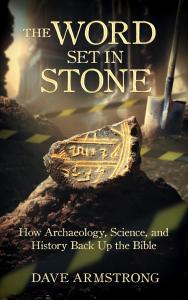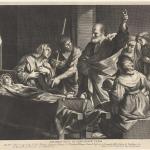This excerpt is the first four-and-a-half pages of Chapter Eleven (“King David Versus King Arthur”) of my book, The Word Set in Stone: How Archaeology, Science, and History Back up the Bible (Catholic Answers Press, March 15, 2023: see further book and purchase information). Bible passages: RSV.
*****
Then all the tribes of Israel came to David at Hebron,
and said, “Behold, we are your bone and flesh.”
—2 SAMUEL 5:1
The substantial historicity of the united monarchy of Judah (reigns of King Saul: c. 1037–c. 1010 B.C., King David: c. 1010–c. 970 B.C., and King Solomon: c. 970–c. 931 B.C.) was widely accepted in the middle years of the twentieth century, even within secular archaeological circles.
But by the 1990s, what is called archaeological or biblical minimalism became quite the fashionable view to take among a new generation of archaeologists who worked in Israel. It was the high-water mark of skepticism, influenced and infused by a marked “anti-biblical” or “anti-traditional,” or what could be called a “vehemently secular,” spirit. Older “truths” were no longer accepted as established or given. Many archaeologists in the 1990s, and continuing until the present time, held or hold a view similar to the following:
Nadav Na’aman, an authority on Jewish history . . . at Tel Aviv University, describes David’s story as “extraordinary fiction.” But he believes that it contains kernels of truth, preserved as the tale was passed down by oral tradition. [188]
In other words, among the minimalists, David is regarded similarly to how most historians view King Arthur: a real person (not nonexistent), but vastly mythologized, to such an extent that the “kernel” of historical truth and fact has been mostly lost amid the colorful and memorable legends built up around him. The late Philip R. Davies, Bible scholar at the University of Sheffield, confidently proclaimed the same: “I’m not the only scholar who suspects that the figure of King David is about as historical as King Arthur.” [189]
Ze’ev Herzog, archaeologist at Tel Aviv University, took an even more extreme view in a 1999 front-page story in the Israeli newspaper Haaretz, titled “The Bible: No Evidence on the Ground”:
Following seventy years of intensive excavations in the Land of Israel, archaeologists have found out: The patriarchs’ acts are legendary, the Israelites did not sojourn in Egypt or make an exodus, they did not conquer the land. Neither is there any mention of the empire of David and Solomon, nor of the source of belief in the God of Israel. These facts have been known for years, but Israelis are a stubborn people, and no one wants to hear it. [190]
I submit that stubbornness and excessive dogmatism are traits not unknown among minimalist archaeologists. Tom Meyer, a biblical scholar at Shasta Bible College in California, described this sort of skepticism among scholars, who thought King David “never existed and was a figment of the imagination of a post-exilic Jewish community who, after returning to Jerusalem from Babylonian captivity in the fifth century B.C., invented King David as a national figure which the fledgling nation could rally around as they rebuilt their country.” [191]
Thomas L. Thompson, professor of Old Testament at the University of Copenhagen, and author of Early History of the Israelite People (1992), stated,
It is out of the question that Saul, David, and Solomon, as described as kings in the Bible, could have existed. I think the biblical accounts are wonderful stories, invented at the time when Jerusalem was part of the Persian Empire in the fifth century B.C. [192]
God has a wonderful sense of humor, and it is often exhibited (or so it seems to me) in the particular timing of new archaeological findings that support the truthfulness and historical trustworthiness of the Bible.
In March 1993, all biblical scholars and archaeologists (minimalist and maximalist alike) agreed that there was no “concrete evidence” outside the Bible (such as in written monuments or documents) of the existence of King David. Then, lo and behold, in July 1993, just four months after the above article that cites Thompson, definitive evidence of this nature (the Tel Dan Stele) was found in Israel. Eric H. Cline, chairman of the Department of Classical and Semitic Languages and Literatures at the George Washington University, told the story in his book, Biblical Archaeology: A Very Short Introduction. A portion of it was adapted for an internet article, “Did David and Solomon Exist?”:
As it is currently reconstructed, the inscription describes the defeat of both Joram, king of Israel, and Ahaziyahu, king of Judah, by a king of Aram-Damascus in the ninth century BCE. [193]
“House of David” is also biblical terminology (1 Sam. 20:16; 2 Sam. 3:1–6; 1 Kings 12:19–26; 2 Chron. 10:19; and many other instances in the RSV). The language of the inscription is a dialect of Aramaic. Most scholars think King Hazael of Damascus (ninth century B.C.) is the author. Prominent Israeli archaeologist Israel Finkelstein, who regards himself as neither a minimalist nor a maximalist (somewhere in the middle of the spectrum), described the decisive importance of this find:
Much of the minimalist effort has been invested in the claim that David and Solomon . . . are not historical figures. They argued that, like Abraham, Moses, Joshua, David, and Solomon are not mentioned in any extra-biblical texts, and should therefore be seen as legendary personalities. This argument suffered a major blow when the Tel Dan basalt stele was discovered in the mid-1990s. . . .
Moreover, it most probably specified the names of the two later kings—Joram of Israel and Ahaziah of Judah— both of whom are mentioned in the biblical text. [194]
Arguably, a second mention of the “House of David” occurs in the Mesha Stele [195] (c. 840 B.C.), connected with King Mesha of Moab, written using a variant of the Phoenician alphabet, closely related to paleo-Hebrew script. It was discovered in August 1868 in Dibhan, Jordan, but re-interpreted in light of the Tel Dan Stele, so that many think it refers to the “House of David” and contains a possible second mention of David.
Opposing views exist, as always. Some think it refers to Balak, a Moabite in the Bible, who lived 200 years before David.
French epigrapher, historian, and philologist André Lemaire had actually suggested a reading of “House of David” in 1992, before the Tel Dan Stele was discovered. [196] An article written by Amanda Borschel-Dan notes how Michael Langlois, of the Center for Judaic Studies at the University of Michigan, used his own fancy high-tech methods to discover something further:
After layering the images together, in a startling discovery, Langlois found a previously overlooked dot, which indicates a break between words throughout the entire tablet, as was customary among scribes at the time. . . .
“In my paper I’m not trying to discuss whether King David exists, just trying to read the stone, and my conclusion for line 31 is that the most likely reading is Beit David, which takes into account the traces of letters and the combination of them,” said Langlois. [197]
FOOTNOTES
188 Ruth Margalit, “In Search of King David’s Lost Empire,” The New Yorker (June 22, 2020).
189 Philip R. Davies, “‘House of David’ Built on Sand: The Sins of the Biblical Maximizers,” Bible Archaeology Report 20:04 (July/August 1994), 55.
190 Cited in Ruth Margalit, “In Search of King David’s Lost Empire”.
191 Cited in Sebastian Kettley, “Archaeology news: ‘Incredible artefact testifies to the existence’ of Bible’s King David,” Express UK (February 15, 2021).
192 Cited in David Keys, “Leading archaeologist says Old Testament stories are fiction,” Independent (March 28, 1993).
193 Eric H. Cline, “Did David and Solomon Exist?,” The Bible and Interpretation (October 2009).
194 Israel Finkelstein and Amihay Mazar, The Quest for the Historical Israel: Debating Archaeology and the History of Early Israel (Atlanta: Society of Biblical Literature, 2007), 14.
195 “The Mesha Stele, or Moabite Stone, a Non-Biblical Text, Confirms Some Events in the Biblical Book of Kings,” History of Information.
196 Amanda Borschel-Dan, “High-tech study of ancient stone suggests new proof of King David’s dynasty,” The Times of Israel (May 3, 2019).
197 Ibid.
***
Practical Matters: Perhaps some of my 4,200+ free online articles (the most comprehensive “one-stop” Catholic apologetics site) or fifty-one books have helped you (by God’s grace) to decide to become Catholic or to return to the Church, or better understand some doctrines and why we believe them.
Or you may believe my work is worthy to support for the purpose of apologetics and evangelism in general. If so, please seriously consider a much-needed financial contribution. I’m always in need of more funds: especially monthly support. “The laborer is worthy of his wages” (1 Tim 5:18, NKJV). 1 December 2021 was my 20th anniversary as a full-time Catholic apologist, and February 2022 marked the 25th anniversary of my blog.
PayPal donations are the easiest: just send to my email address: [email protected]. You’ll see the term “Catholic Used Book Service”, which is my old side-business. To learn about the different methods of contributing, including 100% tax deduction, etc., see my page: About Catholic Apologist Dave Armstrong / Donation Information. Thanks a million from the bottom of my heart!
***
Summary: Excerpt about King David, from my book, The Word Set in Stone: How Archaeology, Science, and History Back up the Bible (Catholic Answers Press, 3-15-23).














